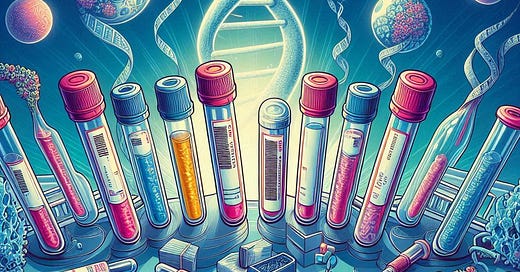Greetings! It’s time to start the Spring Semester (or maybe you already have) and I’ve got a nice little case to jumpstart intuitions about genetics and IVF.
Above is What happens when you put in “IVF and DNA” in Bing’s AI Image generator
The NYT magazine subtitle sums the story up nicely: “Two couples in California discovered they were raising each other’s genetic children. Should they switch their girls?” The Cardinales were enjoying their two month old May but Alexander couldn’t shake the nagging feeling that May didn’t look like any of his Italian relatives and some friends said May had Asian features.
The reason for this nightmare? The IVF clinic both couples used implanted the wrong embryos. Beyond the obvious question of what is most important DNA or Parental bonding, this case highlights an important bioethical puzzle: Why do we privilege genetics over other things?
Just a few months before the Cardinales nightmare began, a lawsuit was filed by a New York woman who gave birth to two boys neither of whom were Korean like their parents. The mother was forced to surrender her two boys to two different families who shared their DNA because, barring any accusations, the law almost always favors genetic parents no matter how old the child.
It makes sense that the law would settle on genetics. DNA has the benefit of being precise, consistent, and definitive. Three things most courts and law scholars love. Parental love and bonding, on the other hand, is subjective, anecdotal, and hard to prove.
The “genetic principle” as Elizabeth Anderson reminds us is ostensibly there to “secure children's interests in having an assured place in the world, which is more firm than the wills of their parents.”1
The genetic principle also places children in a far wider network of associations and obligations than the consent-intent rule sanctions. It supports the roles of grandparents and other relatives in the nurturing of children, and provides children with a possible focus of stability and an additional source of claims to care if their parents cannot sustain a well- functioning household.2
Because a child shares DNA that can be traced to other relatives consistently, this provides next of kin who can care for the child by virtue of their provable genetic ties.
So when the Cardinales saw the genetic test that proved May was not their genetic offspring, they did the descent thing and notified the fertility clinic.
That’s when the second couple got a call where a crying fertility specialist explained that mistakes had been made. This couple declined to reveal their names. By the time the two couples met, the infants were three months old. The infants knew their names and lit up when their parents smiled at them, but they were still forming intellectually and far older children have thrived in adoptions situations where they must bond with a new parent.
What happened after that is really something beautiful. The two mothers bonded not only with their new children but with each other. The families were nit together by more than genetic ties. Each of the four parents slowly, and painfully, came together. The two girls switched before birth have now become “sisters.”
The lawsuit was settled out of court with a very tight non-disclosure agreement, of course.
Just a great little genetic case study to start off your Spring semester. Leave a comment if you have questions or want to add your thoughts.
Elizabeth Anderson “Is Women’s Labor a Commidity?” : Philosophy & Public Affairs , Winter, 1990, Vol. 19, No. 1 (Winter, 1990), pp.
71-92, pg.80.
Ibid.





